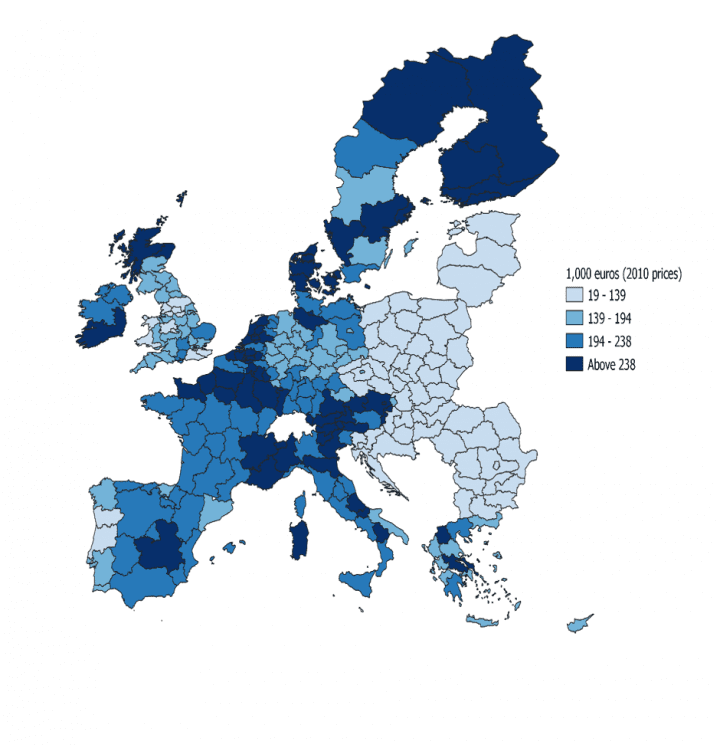European regional data
Cambridge Econometrics’ European regional database is now available free of charge from the newly-created Annual Regional Database of the European Commission’s Directorate General for Regional and Urban Policy (ARDECO).

The database includes an on-line download facility and is maintained and updated by the European Commission’s Joint Research Centre (DG JRC).
Cambridge Econometrics no longer actively updates the database – this is the responsibility of DG JRC-ISPRA.
The ARDECO database is designed to be a regional counterpart to the AMECO database (an annual macro-economic database) by DG EcFIN.
About the European regional database
This database is a wide-ranging, sub-national, pan-EU database of economic indicators, providing a complete and consistent, historical time series of data of NUTS2 and NUTS3 data starting in 1980.
The database includes the following sectoral disaggregation:
- GVA (by 6 sectors)
- Employment (by 6 sectors)
- GDP
- Hours Worked (by 6 sectors)
- Compensation of employees (by 6 sectors)
- Gross fixed capital formation (by 6 sectors)
- Population
- Active population
It is consistent with NACE Rev. 2 sectoral definitions, namely:
- Agriculture, Forestry and Fishing
- Industry (excluding Construction)
- Construction
- Wholesale, Retail, Transport, Accommodation & Food Services, Information and Communication
- Financial & Business Services
- Non-market Services
The data are particularly useful for analysing historical regional trends across Europe, through econometric regression modelling or regional analysis.
Relevant Applications
Regional capital stock estimates
A new approach by Cambridge Econometrics has used the European regional database to produce estimates of regional capital stocks, for the first time, across the EU28. This is based, and improves upon, the original work undertaken for DG Regio by Cambridge Econometrics in 2010.
With these data it is possible to derive capital-labour ratios. These show the capital intensity of firms (aggregated as regional averages) and is strongly related to productivity because firms which seek to automate their output and invest in capital rather than labour typically have higher levels of output per employee.

Map: Capital-labour ratio across EU28 in 2016
This map shows the NUTS2 capital-labour ratio for 2016, currently the latest year of available data. The lowest levels of capital-output ratio are concentrated in Eastern Europe (with exceptions located in parts of Portugal and the UK).
Regions with capital labour-ratios in the middle quartiles are concentrated in Western Europe.
Regions with the highest values of capital-labour ratios are not concentrated in a specific area, with instances of such regions in the north, the centre and the south of Europe, but often are highlighted around capital city regions (e.g. see Madrid in Spain) which can act as attractors for investment via forces of agglomeration.
Analysis of lagging regions
Cambridge Econometrics used its database to produce an analysis of lagging regions in the European Union, focusing on the economic challenges faced by a mix of low-growth and low-income regions (as defined by the EC).
The aim of this project was to deepen understanding of the factors limiting investment, growth and convergence in the lagging regions of the EU, and which policy measures could be taken to overcome these limitations and fully exploit the lagging regions’ development potential.

Ravello, Campania, Italy – one of the EU’s lagging regions
The study assessed the degree to which these regions are held back by the fiscal and macroeconomic conditions under which they operate, as well as the primary requirements of these regions in terms of the need for structural reforms, with particular attention given to measures which could be supported by the European Structural and Investment Funds (ESIF).
The analysis calls for a specific range of policies to address them including reducing labour market rigidities and maintaining public investment.
Economic growth in European regions
The Determinants of Economic Growth in European Regions finds that income convergence between countries is dominated by the catching-up of regions in new member states in Central and Eastern Europe, whereas convergence within countries is driven by regions in old European Union member states.
For further information
Find out more about our expertise in regional data analysis by contacting Director, Ben Gardiner.
If you have any questions relating to these data or future updates, please contact the EU’s Joint Research Centre. The technical note contains information about how the database is constructed.
To discuss any of the analysis above, or to talk through your own particular challenge, please don’t hesitate to contact me.